In literature, regionalism is basically a fictional piece that mainly focuses on the specific characteristics of a certain region. These characteristics may include the customs, dialect, and characteristics that are found in the region in question. In general, regionalism is vividly illustrated in Mark Twain’s “Adventures of Huckleberry Finn.” This is highly evident in his use of words, dialogue, and languages that vividly describe the places and the people along the Mississippi River in the United States.
Basically, regionalism in the novel is first notable in Twain’s use of language. For example, the book often uses the term “nigger” to refer to black people. In addition, the novel also uses various racial stereotypes such as the description of Jim, a young slave whom he travels with for the most part of the story, as a “property” or an object that belongs to his master from the white race. Moreover, Mississippi River is well-known as a historical place for racism and slavery, which provides further substantial evidence that the book tends to focus on specific characteristics of slaves, white people, and racism in the region, in accordance to the definition of regionalism. However, possibly the best example of regionalism in the book is Twain’s characterization of Jim. As a slave, Jim is often perceived as an incompetent and uneducated person who is inferior to the white people. However, in the story, he also shows remarkable intelligence and wit especially when he rescued Huck from the conflict between two Southern aristocrats, which in a way shows that the author was against racism. In short, the novel is largely characterized by color regionalism as it mainly focuses on its conditions of slavery, racism, and other features of past Mississippi River.
Works Cited
Twain, Mark. “Adventures of Huckleberry Finn.” 1885. The Literature Network. 13 April 2009 <http://www.online-literature.com/twain/huckleberry_finn/>.





